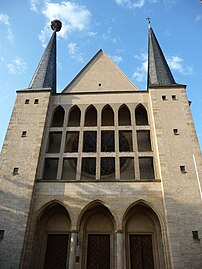St. Peter and Paul (Geinsheim)
|
The facade with a stork's nest on the left tower |
|
| Basic data | |
| Denomination | Roman Catholic |
| place | Neustadt an der Weinstrasse, Germany |
| Building history | |
| Client | Geinsheim community |
| architect | Franz Jacob Schmitt |
| start of building | 1492; 1869-1873 |
| Building description | |
| inauguration | May 4, 1873 |
| Architectural style | Gothic |
| Construction type | Hall construction |
| 49 ° 18 '15.7 " N , 8 ° 15' 22.6" E | |
The Catholic parish church of St. Peter and Paul is the landmark of the former village of Geinsheim , which was incorporated into the district-free town of Neustadt an der Weinstrasse, 10 kilometers to the northwest, in 1969 .
architecture
The church building looks back on more than 500 years of history and consists of two parts, the older part, which was built around 1500 and the newer part, which was built from 1870 to 1873. The mighty building with a 30 meter high double tower facade and the more than 40 meter high single tower of the old church, with the almost 46 meters long, 17 meter wide and 16 meter high nave, the church is the largest of its kind in the Gäu. It is popularly known as the "Gäu Dom". The easternmost of the two double towers has been used as a nesting place by a pair of white storks for years.
The first church (a wooden structure) in Geinsheim is said to have been built around the year 800 and was replaced around 1500 by a new building in the late Gothic style.
Due to the rapid increase in the number of villagers from the end of the 18th century to the middle of the 19th century from 600 to 1500, the church had become too small. The municipal council decided on a new building, which was initially rejected by the royal government, but was then approved by King Maximilian II Joseph of Bavaria in 1860 after many negotiations.
The architect Franz Jacob Schmitt was commissioned with the planning in 1868. The new building was financed by the political community of Geinsheim and consecrated on May 4th 1873 by Speyer Bishop Daniel von Haneberg.
The church was built in a north-south direction, with parts of the old church (choir with sacristy and tower) remaining and being incorporated into the new church. A three-aisled church with a striking double tower facade was created.
Then bad news in the 1950s. The double tower facade had separated from the long walls of the nave and sloped forward. With extensive measures between 1959 and 1961 it was possible to preserve the church.
St. Peter and Paul is the largest church in the "Gäu", a flat area between the German Wine Route and the Rhine in the Upper Rhine Plain . The church is therefore popularly known as the “Gäu Dom”.
organ
The (original) organ was built in 1903 by Gebr. Link (Giengen ad Brenz). The pneumatic work had 26 stops on two manuals and a pedal . In 1963 the organ was rebuilt by master organ builder Hugo Wehr from Haßloch and extended to 31 registers to three manuals, Link's organ case was removed and renewed in the style of the time; In 1988 the pipes were placed on electric slide chests. The organ was last reorganized in 2007-2008 by organ builder Martin Vier (Friesenheim). The hitherto pneumatic Registertrakturen were to electrical tracker action converted, the swell was given a new cone chest and the disposition and intonation were approximated to the state of the year 1903rd The instrument has 40 registers on three manuals and a pedal. The action mechanism and stop action are electric.
|
|
|
|
||||||||||||||||||||||||||||||||||||||||||||||||||||||||||||||||||||||||||||||||||||||||||||||||||||||||||||||||||||||||||||||||||||||||||||
- Coupling : II / I, III / I, I / P, II / P, III / P
Bells
Four bronze bells hang in the tower of St. Peter and Paul. They were cast in the Metz bell foundry in Karlsruhe in 1995.
| No. |
Surname |
Casting year |
Bell caster |
Diameter (mm) |
Weight (kg) |
Nominal |
|---|---|---|---|---|---|---|
| 1 | Joseph | 1995 | Metz bell foundry | 1930 | of the 1st | |
| 2 | Marien | 910 | ges 1 | |||
| 3 | Peter and Paul | 650 | as 1 | |||
| 4th | Wendelinus | b 1 |
photos
history
In the years 1850 and 1851 Paul Josef Nardini was the parish administrator of the parish. Nardini, then 29, made major changes to the parish in just under nine months. In a letter to the bishop, the Catholics of Geinsheim wrote: "Our men have been completely transformed, our children are new, we have all now received the right light." Nobody in Geinsheim, no matter how old they are, has ever " such words of the holy Gospel as heard in these nine months from ... Pastor Dr. Nardini ”.
Web links
- Website of the parish community of Geinsheim on the Church of St. Peter and Paul, Geinsheim. Retrieved December 12, 2014 .
- Private website on the history of the church of Geinsheim. Retrieved December 12, 2014 .
literature
- Steffen Gal: The "Gäu - Dom" Catholic parish church of St. Peter and Paul in Neustadt-Geinsheim. In: The Rhine Palatinate. No. 86, April 13, 2018.
Individual evidence
- ↑ orgelbau-vier.com , accessed on April 16, 2020.
- ^ Website of the parish community in Geinsheim on Pastor Nardini. (No longer available online.) Archived from the original on November 3, 2014 ; Retrieved December 12, 2014 .










